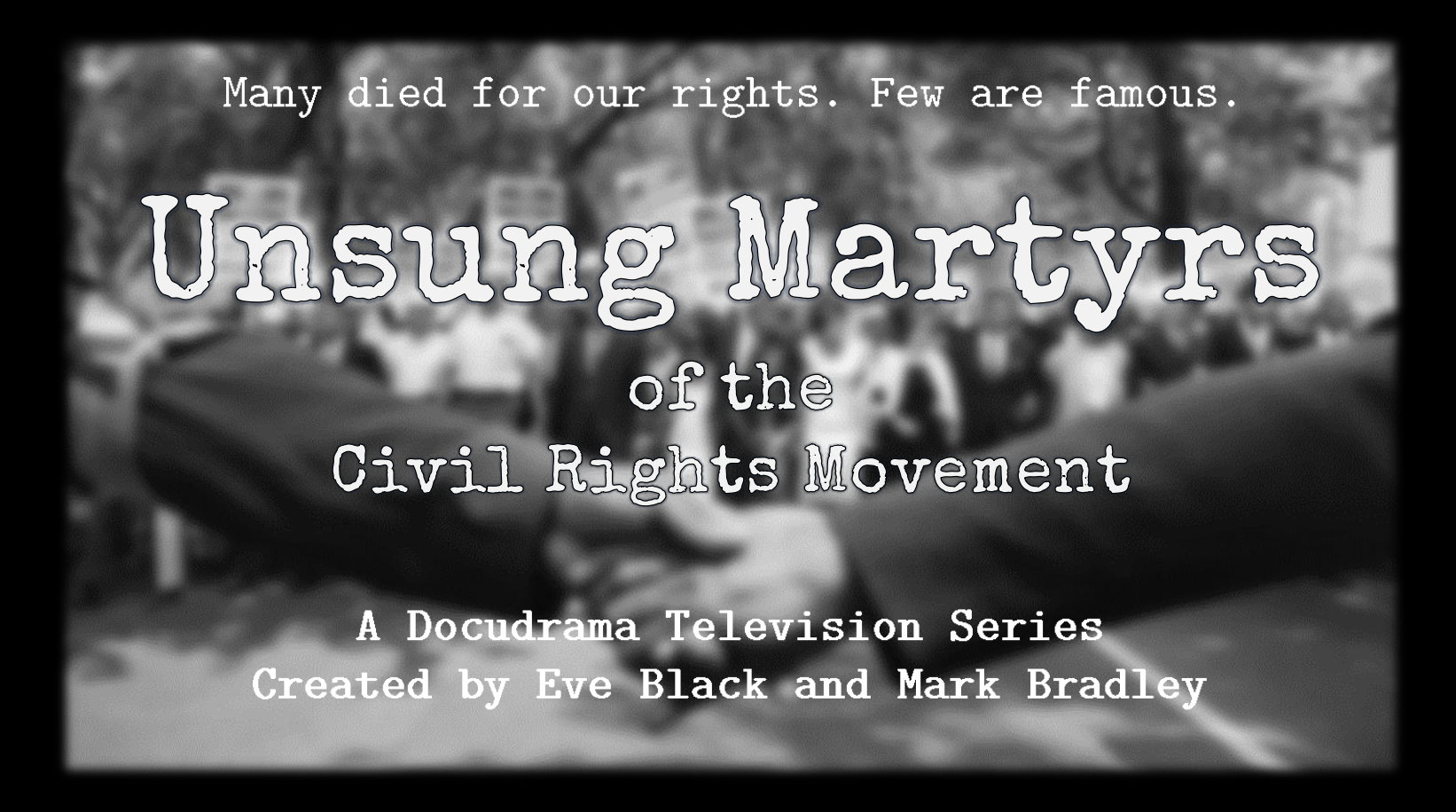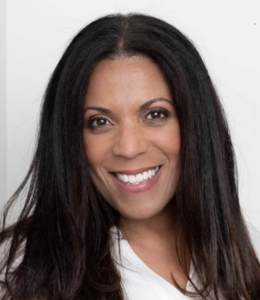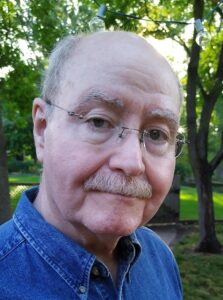Unsung Martyrs of the Civil Rights Movement

Description
In the civil rights movement of the 1950s and 1960s, many people lost their lives in the struggle. Some of their names and stories are familiar. But many other people also lost their lives. People less well known, from all walks of life, who died in the struggle for equality for all Americans. Who were these people? How did they die? And why has so little been done to honor them?
They are the Unsung Martyrs of the Civil Rights Movement, and we tell their stories.
SYNOPSIS:
Most people know about Medgar Evers, Dr. Martin Luther King, and Andrew Goodman, James Chaney, and Michael Schwerner, martyrs of the Civil Rights movement. But there were many other martyrs. People like civil rights leaders Harry and Harriet Moore, whose house was bombed on Christmas Night; or Viola Liuzzo, a housewife from Detroit, who was shot in the head while driving marchers back from Selma; or Rev. George Washington Lee, who urged his parishioners to vote and received three shotgun blasts into his face. These people, and countless others, were killed for doing what was right. Yet their names remain unknown and most of their cases unsolved.
These people died for our rights. For the right of equal access to public services. For the right to get a good education. And of course, for the most fundamental right of all citizens: the right to vote. Recent events have made it clear that America has yet to fully realize its promise of liberty and justice for all. The current widespread attacks on voting rights, and the attempts to turn back the clock on civil liberties and perpetuate white supremacy, mean only one thing: if there was ever a right time for this series, it is now.
THE PILOT:
On the evening of January 11, 1966, 76-year-old Adlena Hamlett and 58-year-old Birdia Keglar, both civil rights activists, were riding in a car after attending a civil rights meeting in Jackson, Mississippi. With them were three young civil rights workers. The women had repeatedly been warned not to participate in civil rights work. Mrs. Hamlett had been hung in effigy. Despite the threats, they attended a secret meeting to discuss civil rights and poverty issues. They watched a film made by the U.S. Commission on Civil Rights and met with Senator Robert F. Kennedy. After the meeting, the group began the 140-mile journey back to Charleston, Mississippi. They would not make it home.
Late that night, a gold Plymouth Fury was found alongside US49E, outside the small town of Sidon, near Greenwood. Civil rights workers Jesse Brewer and Grafton Gray, who was driving, were seriously injured. With Brewer in the back seat was a young white man from Massachusetts. a worker for SNCC, the Student Non-Violent Coordinating Committee. He suffered less serious injuries. But the two women were dead, and their injuries were horrific.
There were immediate suspicions about the car crash. Did Grafton Gray lose control? The road was dry, flat, and relatively straight. Had he fallen asleep? The car was not equipped with seat belts, so why had the women been killed, while the young men suffered far less serious injuries? Sidon was a well-known stronghold of the Ku Klux Klan. Was this just a tragic road accident, or was there something more sinister at work?
Relatives of the women think that the car was deliberately forced off the road, and that the women had been hauled out of the car and tortured by an ambushing gang, in front of the three young men. The women had been decapitated and their arms severed from their bodies. So-called “engineered car crashes” and that type of mutilation were well-known signatures of the Ku Klux Klan.
Of the young men in the car, Jesse Brewer never spoke of what happened that night. Neither did the white SNCC worker from Massachusetts, whom the family could not locate and whose name was not released at the time. Grafton Gray was terrified and refused to talk about the accident. For years afterwards, he would just go out to the edge of a field and cry.
After the death of his mother, Mrs. Keglar’s son James spoke with FBI agents in Clarksdale. Three months later, he was arrested and put into the Clarksdale jail. He was released about midnight. He was found dead the next morning, and his house burned to the ground.
There was a Federal investigation — 40 years later under the Emmett Till Law — but they concluded that there was “insufficient evidence to indicate that the car crash was other than accidental or that their deaths were motivated by their civil rights activism.”
The Federal case was finally closed in 2011. No arrests were ever made.
WHY EVE?
Eve Black is an experienced actor and on-camera presenter. But she also has the civil rights movement quite literally in her blood. Her Aunt Zelma was among the first children to integrate the schools in Topeka, Kansas, following the Brown v. Board of Education ruling in 1954, and her grandfather wrote speeches for the great Fannie Lou Hamer, who changed the face of the Mississippi Democratic party in the 60’s. But of the most relevance to this project: Adlena Hamlett was her great-grandmother.
“My family was very involved in civil rights. And I went through my own experience as a 5-year-old, along with one of my sisters, cousins and my pre-teen aunt and uncle who were the first to integrate Highland Park schools in 1966. This was the same year my great-grandmother was killed. I remember the excitement of the first day of school as a kindergartner, saying goodbye to my mother and getting on the school bus in the Summit-University neighborhood, and my father and another parent following the school bus in their cars to make sure we arrived safely. When we got to Edgecumbe Elementary School, we were escorted out of the bus by police officers, past an angry group of people who were calling us names and saying “Niggers go home we don’t want you here!” I didn’t understand what the word meant, but I knew it was bad. It never occurred to me at that age that people hated me because of the color of my skin. I remember one day when we got to school people were trying tip over our school bus with all of us in it and I remember being scared and saying to my cousin, ‘Why do they want to hurt us?’”
AUDIENCE:
Our audience is people who are interested in serious documentaries about history and social issues. That audience will probably skew older, but we are very anxious to reach a younger audience, as well — high school and even junior high — any audience mature enough to understand the message and to deal with the horrific nature of some of the stories. Reaching that audience is admittedly a challenge, and social media may be the best way to do it. We have also discussed producing a podcast to build awareness and support for the project.
TIMELINE, BUDGET:
2024: Produce a short version of the pilot
Estimated budget: $50,000
MORE INFORMATION:
- Unsung Martyrs was an official Selection at the 2022 Catalyst Festival.
- Unsung Martyrs will be shot with union cast and crews, and will patronize union establishments whenever possible.
PROFILES:
 EVE BLACK: (Co-Creator, Presenter) has been acting primarily in the Twin Cities area for over 30 years as a SAG-AFTRA member. She has worked in Film, TV, Theater, commercials and corporate video and narration and voice-over. She was born in St. Paul and when she was 7, her parents moved to the southern metro suburbs. That same year, she earned her Equity card in Finnian’s Rainbow, which started her love for acting and singing. She went on to graduate from Apple Valley High School and then attended the University of Minnesota. She is a SAG-AFTRA Board member, having served several times over the last 30 years. Currently, she is writing a screenplay based on the life of her great-grandmother Adlena.
EVE BLACK: (Co-Creator, Presenter) has been acting primarily in the Twin Cities area for over 30 years as a SAG-AFTRA member. She has worked in Film, TV, Theater, commercials and corporate video and narration and voice-over. She was born in St. Paul and when she was 7, her parents moved to the southern metro suburbs. That same year, she earned her Equity card in Finnian’s Rainbow, which started her love for acting and singing. She went on to graduate from Apple Valley High School and then attended the University of Minnesota. She is a SAG-AFTRA Board member, having served several times over the last 30 years. Currently, she is writing a screenplay based on the life of her great-grandmother Adlena.
 MARK BRADLEY: (Co-Creator, Writer) Mark’s writing includes a five-part TV adaptation of the novel Under Ground, a stage adaptation of “The Shop Around the Corner,” a screenplay adaptation of a British sex farce, and a one-act play inspired by an episode of The Twilight Zone. His pilot for Dodo in London, a dramedy set during World War II, was a semifinalist in the Pitch Now Season 6 competition, and he is currently working on a screenplay based on his grandfather’s diary from World War I. A long-time union activist, Mark has served on the Equity Liaison Committee and the local and national AFTRA and SAG-AFTRA Boards.
MARK BRADLEY: (Co-Creator, Writer) Mark’s writing includes a five-part TV adaptation of the novel Under Ground, a stage adaptation of “The Shop Around the Corner,” a screenplay adaptation of a British sex farce, and a one-act play inspired by an episode of The Twilight Zone. His pilot for Dodo in London, a dramedy set during World War II, was a semifinalist in the Pitch Now Season 6 competition, and he is currently working on a screenplay based on his grandfather’s diary from World War I. A long-time union activist, Mark has served on the Equity Liaison Committee and the local and national AFTRA and SAG-AFTRA Boards.
 SARA HAMILTON (Consulting Producer) is a development executive, producer, and consultant with 25+ years in film and media, marketing and branding, strategy and business development. She is the Executive Director of The Driftless Film Office in Rochester, MN; an Executive Producer with the global entertainment financial and packaging firm Filmojy; the Head of Partnerships and Development for Catalyst Episodic Story Institute; and a Producing Partner with Superior Studios. In addition to developing and producing films and series, Sara consults with independent producers, studios, businesses, organizations, and non-profits to create meaningful and successful partnerships. She is also an advocate for the film and TV industry, serving on the Boards of FilmNorth, the Minnesota Film Alliance and EntertainMint. Sara was Executive Producer on the award-winning documentary, Time Zero: The Last Year of Polaroid Film, and was Producer of the recent film, Seed of Doubt.
SARA HAMILTON (Consulting Producer) is a development executive, producer, and consultant with 25+ years in film and media, marketing and branding, strategy and business development. She is the Executive Director of The Driftless Film Office in Rochester, MN; an Executive Producer with the global entertainment financial and packaging firm Filmojy; the Head of Partnerships and Development for Catalyst Episodic Story Institute; and a Producing Partner with Superior Studios. In addition to developing and producing films and series, Sara consults with independent producers, studios, businesses, organizations, and non-profits to create meaningful and successful partnerships. She is also an advocate for the film and TV industry, serving on the Boards of FilmNorth, the Minnesota Film Alliance and EntertainMint. Sara was Executive Producer on the award-winning documentary, Time Zero: The Last Year of Polaroid Film, and was Producer of the recent film, Seed of Doubt.
